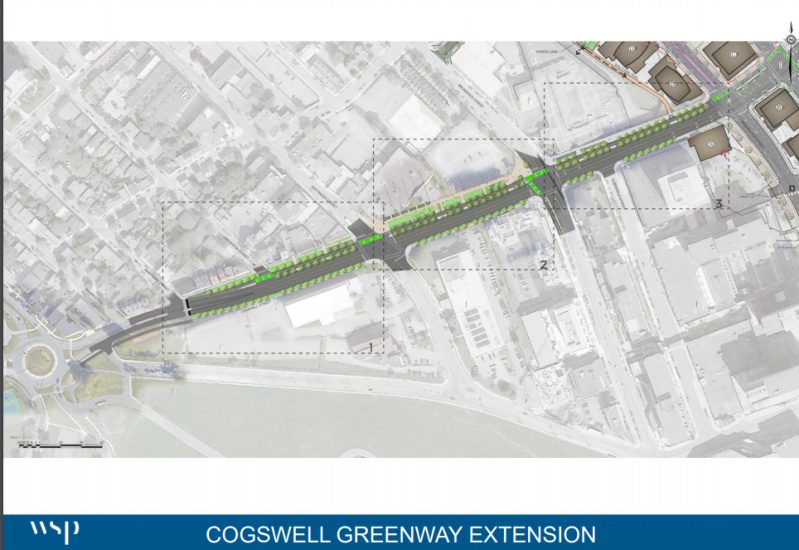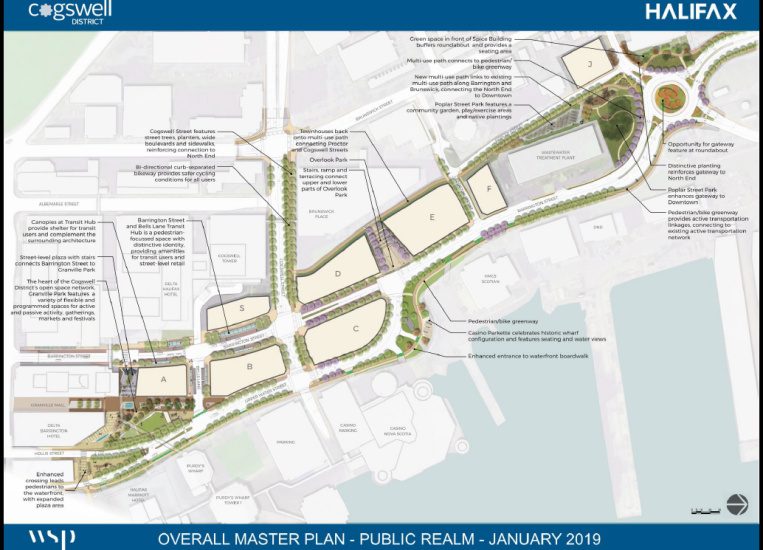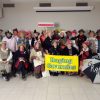
KJIPUKTUK (Halifax) – Out of the blue last weekend an incredible opportunity arose to transform our downtown streets. A funding agreement was announced for a rail cut between the South End container ferry terminal and the Fairview terminal which will take 75% of trucks off our downtown streets.
Downtown minus a large chunk of port traffic is great news and could transform the focus and priorities of our downtown streets. As David Paterson, Regional Autism Co-ordinator with Ready, Willing and Able put it for Halifax Today:
“I think this move not only will increase the comfort of downtown, but also make it a more accessible place for everybody, and really start to push the conversation towards how we make downtown in Halifax built for people, not necessarily trucks and cars.”
Isn’t Cogswell going to be much more people focused?
The Cogswell area fundamentals are; a) we’re finally getting rid of those much loathed flyovers, and b) we’re getting some new public spaces, buildings and streets. That’s good, but a key part of Cogswell remains about shifting large volumes of traffic; Cogswell, Barrington and Upper Water Street will be major four to five traffic lane thoroughfares.

Cogswell Street will remain a wide and long four lane highway, minus the current physical median and with no mid block crosswalks. Crossing points for pedestrians are at signalised intersections only, which we already know from HRM’s incident stats and our own daily experiences are by far the most dangerous and uncomfortable place to cross the road. This makes connectivity on foot between the North End and Downtown challenging because making crossing points wide, infrequent and intimidating deters people from using them.
Halifax is a member of NACTO, an organisation that aims to build cities for people. Cogswell Project Manager Donna Davis confirmed the 90% complete plans comply with NACTO standards. Their street design guidelines refer to four lane thoroughfare streets as daunting for pedestrians to cross, depressing both property values and the quality of public life. Major challenges they refer to include conflict between left hand turning vehicles and pedestrians, which we know is each year the most common cause of pedestrians being hit in HRM.
There are no details on the 90% complete plans which show how pedestrians will be protected from heavy traffic, and no obvious measures to slow traffic as it surges unhalted between signalised intersections.
Given the width of streets, lack of safe and frequent pedestrian crossing points and number of traffic lanes, the overall street design priority seems to be with moving traffic, not people-focused streets which are safe for pedestrians, easy to cross and suited for residential and retail use.
What do we need to make Cogswell a great place to live and hang out?
Downtown streets, especially on a peninsula where we don’t have through traffic, should be pleasant and engaging places to hang out, live, eat, drink and shop. They’re the blueprint to ensure our urban core thrives as the shining light and engine-house of Halifax. The 2018 Cogswell engagement report uses images to demonstrate the benefits of engaging narrower, pedestrianised and people-focused streets, and refers to the need for design elements which minimise conflict between pedestrians and traffic. We didn’t expect Cogswell St to look as it did in the 1920’s, but unfortunately this vital input hasn’t been incorporated into the design plans.

Design consultants Gehl provided a detailed, highly illuminating report on the 60% complete Cogswell plans. They suggested intersection crosswalks should be “scrambles”, which stop traffic in all directions while pedestrians cross in any direction. They provided extensive photographic examples of people-focused streets throughout their report, for example to show the potential of Upper Water Street with a green boulevard down the centre.
Gehl saw the 60% complete plans as prioritising traffic, not people. But they did set exactly how Cogswell could be transformed: Barrington could be a world class pedestrian and transit street if it relates in character to Spring Garden Road, they said. Connections for pedestrians were poor, but they could be improved with crosswalks at a minimum distance of every 80 to 100 metres. A roundabout with more direct pedestrian and cyclist links would prioritise people over traffic flow. This vital game changing feedback and more was not incorporated into the 90% complete plans.
What’s going to make or break Cogswell: People or traffic?
So what changes can we expect by knocking down our current four lane suspended thoroughfares, and replacing them with the same flow of traffic but at ground level? This brings the noise of traffic down to street level and will create an unpleasant and intimidating environment for residents and shoppers. Ultimately their needs should come first because they’re the ones using the commercial assets at Cogswell, not the people driving through it. These people could vote with their feet by not using this new space in favour of areas which are quieter and safer. Bottom line: Without the focus on people, Cogswell may not fulfill its potential.
Are any of our leadership up for changing the plans?
At least one councillor, Sam Austin, understood back in June 2018 that the street plans were necessary due to the truck traffic:
My take on the Cogswell Plan is that it’s solid when you consider the site constraints. While it’s a large piece of land, it’s actually very narrow. It stretches out north to south but has very limited width. In that narrow width, we have to put Barrington Street and all the truck traffic to and from the Port. The trucks will be with us for the foreseeable future and the Port is vital to our community’s economic well-being. The road network needs to be able to accommodate that use until some future date when we get the trucks into the railcut, onto rail, or start ferrying them to the Circ in Woodside.
Downtown Halifax Councillor Waye Mason has a different perspective. Last week he confirmed on twitter that it isn’t too late to change the Cogswell plans, but cites overall existing traffic levels as a reason to maintain the existing plans despite the future decrease in truck traffic.
Could reviewing things now help make a Cogswell that works for everyone?
Public input is over on Cogswell and it seems we remain determined to go ahead with the plans as approved by Council in February and before anyone knew about the rail cut. Could this be a colossal and expensive mistake?
If we were to open up consultation and a review (which would undoubtedly be a positive and enlightened thing to do) I’d like to ask:
- Do we need so many wide thoroughfares to support current vehicle numbers?
- Is supporting current levels of traffic essential? If so, why?
- How many vehicles are single occupant car commuters arriving and leaving at peak times? If commuting journeys are the primary reason for the wide roads, do we want that as our design focus and priority? What does it achieve?
- With a climate emergency declared by Council, does this affect our aims to encourage the same or more levels of traffic with our current street design plans?
- Could streets with reduced traffic lanes encourage alternative more sustainable and healthy modes of transport such as transit, cycling and walking?
- If we were to make Cogswell Street easier to cross by foot from the North End to Downtown, could this boost commuter trips on foot between these two areas?
- Have key people-centred aims identified throughout the consultation process been met?
- With the focus on wide thoroughfares for motorised traffic and lack of safety for pedestrians, will people want to live in and walk through most parts of Cogswell?
- With no evidence of safe and frequent crossing points for pedestrians, how does this meet our Vision Zero road safety policy?
We lose nothing by reviewing the plans in the light of last week’s significant development. My view is that if we don’t address these questions and others put by key people including the disengaged Cogswell stakeholders, we could be setting Cogswell up as an outdated and expensive mistake which misses its potential by a wide margin.
Most of all we need belief and courage from leadership to challenge the status quo. Halifax downtown needn’t be about meeting the needs of traffic flow first, pedestrians second. We’ve received reminders from high profile planners like Jennifer Keesmaat over and over regarding the enormous potential of a people first downtown. It’s time to listen to and act to realise Halifax’s greatest natural asset – people who are willing, able and do walk to work.
If you walk, cycle or use a wheelchair and are affected by road safety issues, please join HRM Safe Streets for Everyone. If your local crosswalk needs a crosswalk flag, please contact the Crosswalk Safety Society. Please remember to report issues affecting your safety to our municipal authorities using the 311 service.
With a special thanks to our generous donors who make publication of the Nova Scotia Advocate possible.
Subscribe to the Nova Scotia Advocate weekly digest and never miss an article again. It’s free!




I’m in agreement with the rail cut for transport trucks considering the frequency and noise being significantly reduced. Just walk or bike down Barrington between the northend and north Street now and one will be terrified. If most pedestrian accidents involve cars turning left, would it not be wise to have left turning arrows or flashing green holding the pedestrian briefly until those cars turn? The traffic planners do a poor job of traffic signals in this city. A good example is the new light at the bottom of Almon and Gottingen streets. If a car is turning left from Gottingen onto Almon anytime around rush hour, good luck trying to get through this light. A simple left turning signal or green flash would help. I’m optimistic about the cogswell exchange. Here’s hoping for a positive outcome.
Thanks Robert, I’m in total agreement!